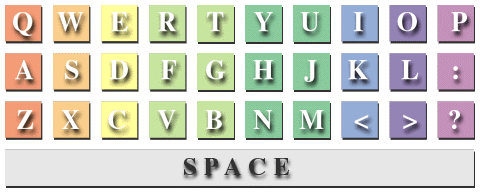 | ||
Try this and our
telephone
demo, too!
Enter text by clicking our keyboard or typing into the text area, or just
load the first two paragraphs of the Gettysburg Address.
Remember to submit! (If you have trouble, try turning on JavaScript.)
 | ||
Minimum motion keyboards are an intriguing idea for high-speed text entry. By using ambiguity resolution, we eliminate the need to move fingers from the home position on a keyboard. In addition to the obvious potential for higher data-entry speeds, such minimum motion keyboards appear likely to reduce to risk of repetitive stress injuries like carpel tunnel syndrome.
Our experiments demonstrate
the practical viability of such minimum-motion keyboards, by
achieving character reconstruction rates of at least 98.4%; for all
standard keyboard layouts, including QWERTY and Dvorak.
Our study of the impact of keyboard layout on reconstruction error
rates shows, surprisingly, that
keyboard designs which balance character frequencies
do not significantly outperform more natural alphabetic layouts.
We have also studied the impact that reducing the number of keys has
on reading comprehension. Through human-factor experiments, we
found that readers are able to accurately understand text entered
using an overloaded keyboard with only 6 keys.
This observation has important implications for such inherently
restricted interfaces such as eye-tracking systems
for the disabled. Current electro-oculography (EOG)
technology only provides sufficient resolution to
implement a 2 by 3 button keyboard.
Our ambiguity resolution techniques
result in EOG systems which are substantially easier to use than
those employing traditional hierarchical menus.
Visitor number: